<center>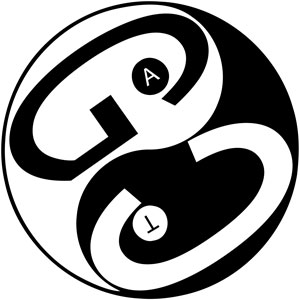</center> ###### <center>You are the guanine-yin to my cytosine-yang.</center> ###### <sub><center>Source: [Wikimedia Commons contributors](https://commons.wikimedia.org/w/index.php?title=File:Yin_yang.svg&oldid=276011970), modified</center></sub> # ## Intro [Watson and Crick got to write a one-page paper](https://steemit.com/biology/@alexander.alexis/the-great-gatc-by-the-most-famous-science-paper-of-the-20th-century) in which they briefly mentioned that "It has not escaped our notice that the specific pairing we have postulated immediately suggests a possible copying mechanism for the genetic material."<sup>[[1](https://www.genome.gov/edkit/pdfs/1953.pdf)]</sup> But how that copying mechanism works, who's to say? Watson and Crick did their abstract work, and the task of proving and elaborating their model fell on other scientists. As they stated in their paper: > The previously published X-ray data on deoxyribose nucleic acid are insufficient for a rigorous test of our structure. So far as we can tell, it is roughly compatible with the experimental data, but it must be regarded as unproved until it has been checked against more exact results.<sup>[[1](https://www.genome.gov/edkit/pdfs/1953.pdf)]</sup> Many "more exact results" would be coming soon. One of them, called by some "the most beautiful experiment in biology"<sup>[[2](https://www.aibs.org/about-aibs/030712_take_the_bioscience_challenge.html)]</sup> (and the subject of this post), would determine which of the tree models of DNA replication popular at the time was the correct model. ## Three model contenders (No, I don't mean runway models. Please pay attention.) According to Watson and Crick's structure, the DNA is made up of two strands, in the conformation of a double helix. But how do these strands copy themselves? Do the strands get copied to create a completely new pair, resulting in one old and one new DNA molecule (conservative model)? Do the strands get separated, with each then giving rise to a complementary strand, so that we end up with pairs that are one part old one part new (semi-conservative model)? Or do patches of DNA get copied piecemeal, resulting in a mottled DNA molecule (dispersive model)? # <center>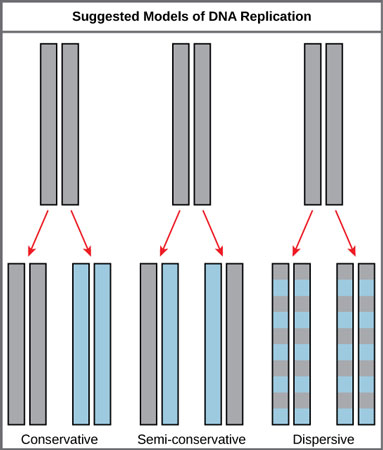</center> ###### <center>Is "dispersive" the new slur for "liberal"?</center> ###### <sub><center>Source: [OpenStax Biology](https://cnx.org/contents/GFy_h8cu@10.120:FyPYFc6h@5/Basics-of-DNA-Replication)</center></sub> # I might've gone for the conservative model. It seems more intuitive. But the model that was favored by Watson and Crick's structure, as well as their words, was the semi-conservative model, due to the complementary structure of the two strands of DNA<sup>[[6](https://www.nature.com/scitable/topicpage/semi-conservative-dna-replication-meselson-and-stahl-421)]</sup>: > [I]t is found that only specific pairs of bases can bond together. These pairs are: adenine (purine) with thymine (pyrimidine), and guanine (purine) with cytosine (pyrimidine). In other words, if an adenine forms one member of a pair, on either chain, then on these assumptions the other member must be thymine; similarly for guanine and cytosine. [...] **[I]t follows that if the sequence of bases on one chain, is given, then the sequence on the other chain is automatically determined.**<sup>[[1](https://www.genome.gov/edkit/pdfs/1953.pdf)]</sup> Watson and Crick proceeded to quote Chargaff's rule, according to which the amounts of adenine are equal to the amounts of thymine, and the amounts of guanine are equal to the amounts of cytosine.<sup>[[3](https://en.wikipedia.org/w/index.php?title=Chargaff%27s_rules&oldid=812880199)]</sup> So it seemed, from this evidence, that each new strand got made from the template of an old strand. If you got one pair you can deduce the other. They fit each other like a yin fits a yang. But how could one go about deciding between the models? How could you tell what was going on at the molecular level, given the technology they had in the late 50s? ## The Meselson-Stahl experiment # <center></center> ###### <center>A real beut!</center> ###### <sub><center>Source: [Freegreatpicture](http://maxpixel.freegreatpicture.com/Test-Tube-Tube-Glass-Bulb-Chemistry-Medical-Glass-867743)</center></sub> # They say beauty is in the eye of the beholder, and no two people react the same when they look at a test tube. But the simplicity and ingeniousness of the Meselson-Stahl experiment led to some calling it "the most beautiful experiment in biology"<sup>[[2](https://www.aibs.org/about-aibs/030712_take_the_bioscience_challenge.html)]</sup>. Everyone knew the different models from the previous section made different predictions, depending on their different combinations of old and new strands of DNA. But how can you tell which strands are old and which ones are new? American geneticists Matthew Meselson and Franklin Stahl devised a way for us to tell. Inspired by previous experiments in which molecules were intelligently labeled to differentiate them (as was done with sulfur and phosphorus in [the Great Kitchen Blender Experiments](https://steemit.com/biology/@alexander.alexis/the-great-kitchen-blender-experiments-how-dna-was-proved-to-be-the-seat-of-heredity)), Meselson and Stahl thought of a new way to label old and new DNA strands. The organism they used for their experiment was the *E. Coli*. The element they chose to use as a label were two nitrogen isotopes, <sup>15</sup>N and <sup>14</sup>N, the former heavier than the latter. Since DNA is partly made of nitrogen, in order to make more of itself it would feed on whichever isotope was present when it replicated. So they started by growing *E. Coli* in medium containing <sup>15</sup>N. They did this long enough for all the DNA to be made only of the heavy isotope. Then they switched them to a medium containing <sup>14</sup>N, and took samples from each successive generation of *E. Coli*. Every sample they took, they centrifuged. This caused the heavier elements to go nearer the bottom of the test tube, and lighter elements to go nearer the top. That's because the solution in which they poured the samples was cesium chloride, which acted as a density gradient, with heavier elements migrating nearer the bottom end and staying there, and lighter elements migrating nearer the top end. Knowing all this, what would your predictions be depending on which DNA replication model was right? Let's see what happened. This is the generation 0 test tube, when the *E. Coli* DNA is made up entirely of <sup>15</sup>N: # <center>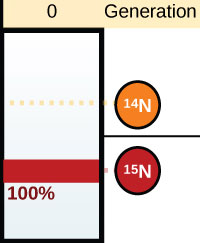</center> ###### <sub><center>Source: [OpenStax Biology](https://cnx.org/contents/GFy_h8cu@10.120:FyPYFc6h@5/Basics-of-DNA-Replication), modified</center></sub> # There's only <sup>15</sup>N, and so it forms a single band, as was expected. This is the sample taken after one generation, the Gen 1 sample if you will: # <center>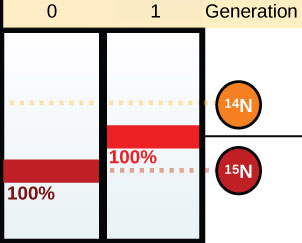</center> ###### <sub><center>Source: [OpenStax Biology](https://cnx.org/contents/GFy_h8cu@10.120:FyPYFc6h@5/Basics-of-DNA-Replication), modified</center></sub> # Even from the get-go first generation, Meselson and Stahl were able to reject the conservative model of replication. That's because, if the old strand pairs remained intact, and completely new pairs (with <sup>14</sup>N) were made from them (as the conservative model entailed), we would expect to see two distinct bands, not one. The one single band we see indicates hybrids, and that indicates old strands combined with new ones, half <sup>14</sup>N, half <sup>15</sup>N, intertwined so they take the halfway position between where <sup>14</sup>N and <sup>15</sup>N would be if they were separate. This proves that the conservative model is wrong. (Sorry Republicans!) That's all very good, but we still haven't decided between the semi-conservative and dispersive models. That's done in the further generations. # <center>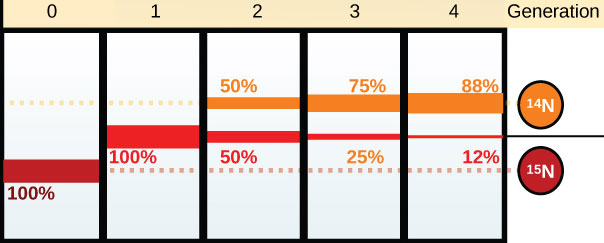</center> ###### <sub><center>Source: [OpenStax Biology](https://cnx.org/contents/GFy_h8cu@10.120:FyPYFc6h@5/Basics-of-DNA-Replication), modified</center></sub> # In the second gen we see two distinct bands, indicating that the strands have separated and half of them are old paired with new <sup>14</sup>N, so they occupy the previous level, and half are new paired with new <sup>14</sup>N, in other words 100% <sup>14</sup>N, so they occupy the <sup>14</sup>N level. If the dispersive model was correct, we would still observe a single band moving up toward the <sup>14</sup>N position, since all the DNA would be made of pieces of old and new DNA combined, so they would move in tandem. As the generations progress, we continue to see distinct bands, as the new strands compose themselves of <sup>14</sup>N and become more numerous. If the dispersive model was the correct model, we would see a single band moving further up the gradient. Therefore, the dispersive model is clearly out of the picture. And there you have it folks, the elegantly simple and hence beautiful experiment by Meselson and Stahl, which you can appreciate even further in [this interactive animation](https://www.dnalc.org/view/15879-Semi-conservative-replication.html). As explained [here](https://www.huffingtonpost.com/ian-glynn/elegance-in-science_b_2819612.html), the concept of "beautiful", when describing experiments or proofs in science, refers to simplicity, creativity, economy, imaginitiveness, and elegance. The Meselson-Stahl experiment exemplifies all of those nouns, so it can certainly be called beautiful (though I personally wouldn't call it *the most* beautiful, since I prefer some of the experiments described [here](https://steemit.com/biology/@alexander.alexis/finding-counting-and-ordering-genes-using-incredibly-sophisticated-biomolecular-megatechnology) and in future posts). ## Outro # <center>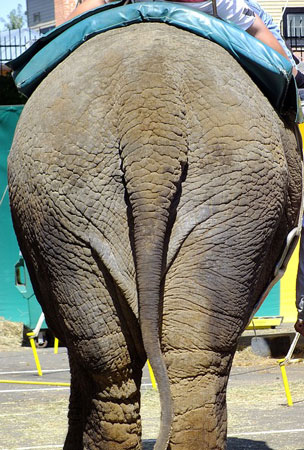</center> ###### <center>The elephant-ass, a Republican-Democrat semi-conservative combo.</center> ###### <sub><center>Source: [Pixabay](https://pixabay.com/p-677712/?no_redirect)</center></sub> # Though many at the time saw it as speculation, the Meselson-Stahl experiment helped to solidify the Watson-Crick double-helix as the correct model for DNA's structure.<sup>[[9](http://www.pnas.org/content/101/52/17895.full)]</sup> Following Meselson and Stahl's experiment, other scientists were able to show the same results in every other organism they studied. To this day, semi-conservative replication is the only kind of replication that is found.<sup>[[6](https://www.nature.com/scitable/topicpage/semi-conservative-dna-replication-meselson-and-stahl-421)]</sup> Be you Republican or Democrat, your DNA falls right in the middle, choosing to replicate semi-conservatively! ##### REFERENCES <sup> 1. J. D. WATSON & F. H. C. CRICK. Molecular Structure of Nucleic Acids: A Structure for Deoxyribose Nucleic Acid. Nature 171, 737–738 (25 April 1953). https://www.genome.gov/edkit/pdfs/1953.pdf </sup> <sup> 2. Biology's Most Beautiful https://www.aibs.org/about-aibs/030712_take_the_bioscience_challenge.html </sup> <sup> 3. Wikipedia contributors, "Chargaff's rules," Wikipedia, The Free Encyclopedia, https://en.wikipedia.org/w/index.php?title=Chargaff%27s_rules&oldid=812880199 (accessed January 23, 2018). </sup> <sup> 4. OpenStax, Biology. OpenStax CNX. Dec 19, 2017 http://cnx.org/contents/185cbf87-c72e-48f5-b51e-f14f21b5eabd@10.120. </sup> <sup> 5. Wikipedia contributors, "Semiconservative replication," Wikipedia, The Free Encyclopedia, https://en.wikipedia.org/w/index.php?title=Semiconservative_replication&oldid=814500625 (accessed January 23, 2018). </sup> <sup> 6. Pray, L. (2008) Semi-conservative DNA replication: Meselson and Stahl. Nature Education 1(1):98 https://www.nature.com/scitable/topicpage/semi-conservative-dna-replication-meselson-and-stahl-421 </sup> <sup> 7. Ian Glynn. Elegance in Science: The Beauty of Simplicity. https://www.huffingtonpost.com/ian-glynn/elegance-in-science_b_2819612.html </sup> <sup> 8. Meselson M, Stahl FW. THE REPLICATION OF DNA IN ESCHERICHIA COLI. Proceedings of the National Academy of Sciences of the United States of America. 1958;44(7):671-682. https://www.ncbi.nlm.nih.gov/pmc/articles/PMC528642/ </sup> <sup> 9. Tinsley H. Davis. Meselson and Stahl: The art of DNA replication. PNAS December 28, 2004 vol. 101 no. 52. http://www.pnas.org/content/101/52/17895.full</sup> --- Earlier *Introduction to Biology* episodes: 10: [The Great GATC-by: The Most Famous Science Paper of the 20th Century](https://steemit.com/biology/@alexander.alexis/the-great-gatc-by-the-most-famous-science-paper-of-the-20th-century) 9: [The Great Kitchen Blender Experiments: How DNA was proved to be the seat of heredity](https://steemit.com/biology/@alexander.alexis/the-great-kitchen-blender-experiments-how-dna-was-proved-to-be-the-seat-of-heredity) 8: [Finding, Counting, and Ordering Genes Using Incredibly Sophisticated Biomolecular Megatechnology](https://steemit.com/biology/@alexander.alexis/finding-counting-and-ordering-genes-using-incredibly-sophisticated-biomolecular-megatechnology) 7: [Christmas Disease — Yes, it's real, 100% scientifically proven!](https://steemit.com/biology/@alexander.alexis/christmas-disease-yes-it-s-real-100-scientifically-proven) 6: [The Most Famous All-Nighter in the History of Genetics](https://steemit.com/biology/@alexander.alexis/the-most-famous-all-nighter-in-the-history-of-genetics) 5: [Mendel's Lucky Number Seven — The law of genetics that almost wasn't](https://steemit.com/biology/@alexander.alexis/mendel-s-lucky-number-seven-the-law-of-genetics-that-almost-wasn-t) 4: [How Cells Use Logic To Do The Impossible](https://steemit.com/biology/@alexander.alexis/how-cells-use-logic-to-do-the-impossible) 3 : [Armchair Science — The Discovery of Proteins' Secondary Structure](https://steemit.com/biology/@alexander.alexis/armchair-science-the-discovery-of-proteins-secondary-structure) 2 : [How Cell Membranes Form Spontaneously](https://steemit.com/biology/@alexander.alexis/how-cell-membranes-form-spontaneously) 1 : [Eduard Buchner: The Man Who Killed Vitalism](https://steemit.com/steemstem/@alexander.alexis/eduard-buchner-the-man-who-killed-vitalism) --- steemSTEM is the go-to place for science on Steemit. Check it out at @steemstem or browse the #steemSTEM tag or chat live at [steemit.chat](https://steemit.chat/channel/steemSTEM) or [discord](https://discord.gg/j29kgjS)
| author | alexander.alexis |
|---|---|
| permlink | the-most-beautiful-experiment-in-biology |
| category | biology |
| json_metadata | {"tags":["biology","steemstem","science","dna","history"],"users":["steemstem"],"image":["https://steemitimages.com/DQmRVNicUcqzEVKQNb5mEGBCWZBWa2nVDindqn6KJ7Xgqnc/2000px-Yin_yang-.jpg","https://steemitimages.com/DQme3xPPVVzFu5Y127Yr8vaGAEPEhjrmvjBK8MycLhFZKBT/Figure_14_03_01-.jpg","https://steemitimages.com/DQmTUZWuA1c7ga32Pa1wwHhbNfegthNaQgRb7upTgSExhBT/maxpixel.freegreatpicture-.jpg","https://steemitimages.com/DQmTJ9BiyoUwXQAb3RbmQziy53kMXpzGBFFFuLpPVwSANtZ/gen0.jpg","https://steemitimages.com/DQmZWzXvDAX1hEJn2ugFZDJh8kEzaEbh7EtqzTomcgzYksu/gen1.jpg","https://steemitimages.com/DQmeKRzwJecug8SycMqMFA3G9KvLmeaHg3TYVabxmf39EAA/gen2etc.jpg","https://steemitimages.com/DQmbCP7jQSw36W59eroh9ceM9wE8zKB7gV9gNFr8fv6Tin4/elephant-677712_640-.jpg"],"links":["https://commons.wikimedia.org/w/index.php?title=File:Yin_yang.svg&oldid=276011970","https://steemit.com/biology/@alexander.alexis/the-great-gatc-by-the-most-famous-science-paper-of-the-20th-century","https://www.genome.gov/edkit/pdfs/1953.pdf","https://www.aibs.org/about-aibs/030712_take_the_bioscience_challenge.html","https://cnx.org/contents/GFy_h8cu@10.120:FyPYFc6h@5/Basics-of-DNA-Replication","https://www.nature.com/scitable/topicpage/semi-conservative-dna-replication-meselson-and-stahl-421","https://en.wikipedia.org/w/index.php?title=Chargaff%27s_rules&oldid=812880199","http://maxpixel.freegreatpicture.com/Test-Tube-Tube-Glass-Bulb-Chemistry-Medical-Glass-867743","https://steemit.com/biology/@alexander.alexis/the-great-kitchen-blender-experiments-how-dna-was-proved-to-be-the-seat-of-heredity","https://www.dnalc.org/view/15879-Semi-conservative-replication.html","https://www.huffingtonpost.com/ian-glynn/elegance-in-science_b_2819612.html","https://steemit.com/biology/@alexander.alexis/finding-counting-and-ordering-genes-using-incredibly-sophisticated-biomolecular-megatechnology","https://pixabay.com/p-677712/?no_redirect","http://www.pnas.org/content/101/52/17895.full","https://en.wikipedia.org/w/index.php?title=Chargaff%27s_rules&oldid=812880199","http://cnx.org/contents/185cbf87-c72e-48f5-b51e-f14f21b5eabd@10.120","https://en.wikipedia.org/w/index.php?title=Semiconservative_replication&oldid=814500625","https://www.ncbi.nlm.nih.gov/pmc/articles/PMC528642/","https://steemit.com/biology/@alexander.alexis/christmas-disease-yes-it-s-real-100-scientifically-proven","https://steemit.com/biology/@alexander.alexis/the-most-famous-all-nighter-in-the-history-of-genetics","https://steemit.com/biology/@alexander.alexis/mendel-s-lucky-number-seven-the-law-of-genetics-that-almost-wasn-t","https://steemit.com/biology/@alexander.alexis/how-cells-use-logic-to-do-the-impossible","https://steemit.com/biology/@alexander.alexis/armchair-science-the-discovery-of-proteins-secondary-structure","https://steemit.com/biology/@alexander.alexis/how-cell-membranes-form-spontaneously","https://steemit.com/steemstem/@alexander.alexis/eduard-buchner-the-man-who-killed-vitalism","https://steemit.chat/channel/steemSTEM","https://discord.gg/j29kgjS"],"app":"steemit/0.1","format":"markdown"} |
| created | 2018-01-23 21:58:21 |
| last_update | 2018-01-23 22:26:36 |
| depth | 0 |
| children | 16 |
| last_payout | 2018-01-30 21:58:21 |
| cashout_time | 1969-12-31 23:59:59 |
| total_payout_value | 107.429 HBD |
| curator_payout_value | 32.775 HBD |
| pending_payout_value | 0.000 HBD |
| promoted | 0.000 HBD |
| body_length | 15,242 |
| author_reputation | 21,140,508,991,402 |
| root_title | "The Most Beautiful Experiment In Biology" |
| beneficiaries | [] |
| max_accepted_payout | 1,000,000.000 HBD |
| percent_hbd | 10,000 |
| post_id | 31,750,832 |
| net_rshares | 12,944,950,254,705 |
| author_curate_reward | "" |
| voter | weight | wgt% | rshares | pct | time |
|---|---|---|---|---|---|
| pharesim | 0 | 89,158,668,591 | 0.09% | ||
| lafona-miner | 0 | 1,172,083,210,972 | 20% | ||
| kushed | 0 | 24,443,449,205 | 11.7% | ||
| justtryme90 | 0 | 2,326,278,332,849 | 100% | ||
| anwenbaumeister | 0 | 192,949,175,105 | 11.7% | ||
| roelandp | 0 | 522,717,836,012 | 5.85% | ||
| zoicneo | 0 | 722,403,490 | 100% | ||
| liberosist | 0 | 656,732,812,572 | 11.7% | ||
| toxichan | 0 | 2,711,159,240 | 11.7% | ||
| velourex | 0 | 18,232,404,883 | 11.7% | ||
| lemouth | 0 | 111,213,893,822 | 32% | ||
| rjbauer85 | 0 | 1,088,041,008 | 40% | ||
| anarchyhasnogods | 0 | 55,198,588,525 | 20% | ||
| lamouthe | 0 | 7,199,135,324 | 40% | ||
| plotbot2015 | 0 | 90,346,034,840 | 100% | ||
| steemedia | 0 | 1,279,914,023 | 11.7% | ||
| meerkat | 0 | 307,875,947,269 | 11.7% | ||
| remlaps1 | 0 | 15,471,671,342 | 22% | ||
| curie | 0 | 541,383,096,112 | 11.7% | ||
| cebymaster | 0 | 1,593,904,147 | 11.7% | ||
| hendrikdegrote | 0 | 5,418,284,565,767 | 11.7% | ||
| steemstem | 0 | 390,135,545,630 | 40% | ||
| cotidiana | 0 | 1,424,926,495 | 11.7% | ||
| teofilex11 | 0 | 7,411,918,422 | 11.7% | ||
| foundation | 0 | 2,994,606,704 | 40% | ||
| the-devil | 0 | 7,356,412,393 | 40% | ||
| timothyb | 0 | 80,413,475,628 | 100% | ||
| remlaps2 | 0 | 1,842,319,285 | 100% | ||
| cheah | 0 | 9,724,391,981 | 11.7% | ||
| dna-replication | 0 | 14,992,391,549 | 65% | ||
| dimitrisp | 0 | 26,593,781,957 | 100% | ||
| themadgoat | 0 | 3,370,593,478 | 100% | ||
| lisa.palmer | 0 | 1,644,587,868 | 100% | ||
| cub2 | 0 | 51,150,863 | 100% | ||
| pacokam8 | 0 | 309,912,901 | 2.34% | ||
| iamsgr | 0 | 2,082,579,848 | 11.7% | ||
| soo.chong163 | 0 | 95,700,840,551 | 35% | ||
| dickturpin | 0 | 3,489,670,429 | 11.7% | ||
| mobbs | 0 | 57,870,595,730 | 34% | ||
| bp423 | 0 | 2,534,787,286 | 11.7% | ||
| kryzsec | 0 | 9,712,744,690 | 61% | ||
| jakipatryk | 0 | 29,306,484,659 | 100% | ||
| cryptonewb | 0 | 983,469,909 | 100% | ||
| loveisintheair | 0 | 6,988,162,683 | 35% | ||
| trumpman | 0 | 68,159,627,708 | 52% | ||
| abishai | 0 | 57,062,867,602 | 100% | ||
| locikll | 0 | 839,270,984 | 4% | ||
| dber | 0 | 25,010,374,667 | 40% | ||
| suzanrs | 0 | 0 | 100% | ||
| kerriknox | 0 | 133,526,811,209 | 40% | ||
| alexander.alexis | 0 | 23,482,114,080 | 100% | ||
| motormouth | 0 | 1,109,720,038 | 100% | ||
| rockeynayak | 0 | 206,019,383 | 40% | ||
| ruth-girl | 0 | 65,231,431,531 | 50% | ||
| mystifact | 0 | 5,202,641,861 | 40% | ||
| ludmila.kyriakou | 0 | 1,224,389,093 | 100% | ||
| maitland | 0 | 0 | 0% | ||
| winstonalden | 0 | 19,412,510,109 | 35% | ||
| tking77798 | 0 | 9,675,974,373 | 100% | ||
| mcw | 0 | 6,401,783,548 | 20% | ||
| taylor.swift | 0 | 139,467,114 | 26% | ||
| gamesjoyce | 0 | 2,005,690,891 | 11.7% | ||
| horpey | 0 | 3,450,417,890 | 40% | ||
| zest | 0 | 2,216,576,523 | 5% | ||
| dysprosium | 0 | 35,376,058,982 | 100% | ||
| cryptonator | 0 | 5,003,222,813 | 11.7% | ||
| moises2612 | 0 | 497,516,078 | 100% | ||
| pierlave | 0 | 2,140,343,152 | 100% | ||
| onart | 0 | 1,728,420,294 | 15% | ||
| erh.germany | 0 | 32,919,032,896 | 100% | ||
| carloserp-2000 | 0 | 4,246,569,160 | 40% | ||
| rachelsmantra | 0 | 1,330,266,310 | 40% | ||
| altherion | 0 | 7,261,576,286 | 20% | ||
| gra | 0 | 11,524,939,148 | 40% | ||
| tfcoates | 0 | 4,316,573,894 | 25% | ||
| seanlloyd | 0 | 38,282,969,405 | 100% | ||
| sci-guy | 0 | 87,306,153 | 40% | ||
| wajahatsardar | 0 | 4,958,496,427 | 11.7% | ||
| kenadis | 0 | 6,680,913,636 | 40% | ||
| amavi | 0 | 24,398,938,595 | 40% | ||
| alexs1320 | 0 | 13,533,844,088 | 100% | ||
| gentleshaid | 0 | 8,457,907,733 | 40% | ||
| hadji | 0 | 768,153,812 | 40% | ||
| mcbk | 0 | 328,801,324 | 100% | ||
| vinamra | 0 | 608,349,965 | 100% | ||
| crowolf | 0 | 116,750,123 | 100% | ||
| dineshgeorgia | 0 | 337,960,801 | 100% | ||
| reviewsuk | 0 | 79,831,746 | 100% | ||
| virtuouscircle | 0 | 537,663,881 | 100% | ||
| delaneycolm | 0 | 556,094,425 | 100% | ||
| korcis | 0 | 614,468,937 | 100% | ||
| qiyi | 0 | 0 | 100% |
@originalworks
| author | alexander.alexis |
|---|---|
| permlink | re-alexanderalexis-the-most-beautiful-experiment-in-biology-20180123t221036783z |
| category | biology |
| json_metadata | {"tags":["biology"],"users":["originalworks"],"app":"steemit/0.1"} |
| created | 2018-01-23 22:10:36 |
| last_update | 2018-01-23 22:10:36 |
| depth | 1 |
| children | 0 |
| last_payout | 2018-01-30 22:10:36 |
| cashout_time | 1969-12-31 23:59:59 |
| total_payout_value | 0.000 HBD |
| curator_payout_value | 0.000 HBD |
| pending_payout_value | 0.000 HBD |
| promoted | 0.000 HBD |
| body_length | 14 |
| author_reputation | 21,140,508,991,402 |
| root_title | "The Most Beautiful Experiment In Biology" |
| beneficiaries | [] |
| max_accepted_payout | 1,000,000.000 HBD |
| percent_hbd | 10,000 |
| post_id | 31,753,264 |
| net_rshares | 0 |
Truly beautiful. I think it's very important for current scientists to learn from how discoveries were made with very elegant and relatively simple experiments like that before we had fancy next generation sequencing and mass spectrometers :)
| author | carlgbush |
|---|---|
| permlink | re-alexanderalexis-the-most-beautiful-experiment-in-biology-20180124t211513249z |
| category | biology |
| json_metadata | {"tags":["biology"],"app":"steemit/0.1"} |
| created | 2018-01-24 21:15:12 |
| last_update | 2018-01-24 21:15:12 |
| depth | 1 |
| children | 1 |
| last_payout | 2018-01-31 21:15:12 |
| cashout_time | 1969-12-31 23:59:59 |
| total_payout_value | 0.078 HBD |
| curator_payout_value | 0.026 HBD |
| pending_payout_value | 0.000 HBD |
| promoted | 0.000 HBD |
| body_length | 242 |
| author_reputation | 739,579,042,374 |
| root_title | "The Most Beautiful Experiment In Biology" |
| beneficiaries | [] |
| max_accepted_payout | 1,000,000.000 HBD |
| percent_hbd | 10,000 |
| post_id | 32,020,655 |
| net_rshares | 11,127,977,547 |
| author_curate_reward | "" |
| voter | weight | wgt% | rshares | pct | time |
|---|---|---|---|---|---|
| alexander.alexis | 0 | 11,127,977,547 | 50% |
Very true.
| author | alexander.alexis |
|---|---|
| permlink | re-carlgbush-re-alexanderalexis-the-most-beautiful-experiment-in-biology-20180125t012225656z |
| category | biology |
| json_metadata | {"tags":["biology"],"app":"steemit/0.1"} |
| created | 2018-01-25 01:22:24 |
| last_update | 2018-01-25 01:22:24 |
| depth | 2 |
| children | 0 |
| last_payout | 2018-02-01 01:22:24 |
| cashout_time | 1969-12-31 23:59:59 |
| total_payout_value | 0.000 HBD |
| curator_payout_value | 0.000 HBD |
| pending_payout_value | 0.000 HBD |
| promoted | 0.000 HBD |
| body_length | 10 |
| author_reputation | 21,140,508,991,402 |
| root_title | "The Most Beautiful Experiment In Biology" |
| beneficiaries | [] |
| max_accepted_payout | 1,000,000.000 HBD |
| percent_hbd | 10,000 |
| post_id | 32,065,031 |
| net_rshares | 1,488,734,942 |
| author_curate_reward | "" |
| voter | weight | wgt% | rshares | pct | time |
|---|---|---|---|---|---|
| ludmila.kyriakou | 0 | 1,488,734,942 | 100% |
I wonder if what the scientific findings and applications already have taken man over the edge of the possibility of not being able to go back the path we so far went. ... Or ... no - I do not wonder but suspect that this not possible. And I also don't know if it is desirable. Probably not. I have great difficulties to understand the things you write about, though I like to comment but then must search things I can refer to. So I would like to ask a general question which other readers might have, too: As it is mentioned and published about genes are "found to be the source of life" (using my own wording but you know what I mean): From your perspective: what is your hope and are those hopes of yours connected to fears as well related to investigating DNA? I do ask this question because I consider your field of science to have a great influence on humanity - and I am afraid to put up an aversion against this topic. People speak of "overcoming disease" and "stretching life spans" related to genetics and I wonder about the intentions of people actually working in this field. Sometimes I feel irritated by the fact that scientific related articles do not give answer about the personal intentions of the scientist him- or herself. I perfectly understand that it should be a separate thing and to find out about personal intentions one simply can ask the pro or find out within building up a relationship. Finally arrived to this, I dare to throw this into your comment-section. Also, I mentioned you today in my article. Me commenting reveals that I myself have some difficulties to marry science & love. But I try and strive to connection and similarities instead of separation and aversion. You might help me out:)
| author | erh.germany |
|---|---|
| permlink | re-alexanderalexis-the-most-beautiful-experiment-in-biology-20180126t102805977z |
| category | biology |
| json_metadata | {"tags":["biology"],"app":"steemit/0.1"} |
| created | 2018-01-26 10:28:06 |
| last_update | 2018-01-26 10:28:06 |
| depth | 1 |
| children | 1 |
| last_payout | 2018-02-02 10:28:06 |
| cashout_time | 1969-12-31 23:59:59 |
| total_payout_value | 0.146 HBD |
| curator_payout_value | 0.049 HBD |
| pending_payout_value | 0.000 HBD |
| promoted | 0.000 HBD |
| body_length | 1,742 |
| author_reputation | 73,742,580,962,927 |
| root_title | "The Most Beautiful Experiment In Biology" |
| beneficiaries | [] |
| max_accepted_payout | 1,000,000.000 HBD |
| percent_hbd | 10,000 |
| post_id | 32,436,453 |
| net_rshares | 21,879,956,019 |
| author_curate_reward | "" |
| voter | weight | wgt% | rshares | pct | time |
|---|---|---|---|---|---|
| alexander.alexis | 0 | 21,879,956,019 | 100% |
Thanks for taking the time to read and comment! I would say that most scientists hold the belief that TRUTH will most of the time be beneficial to us, so investigating genes or whatever will ultimately help us. We are basically learning to control nature, in order to realize our values (or satisfy our desires, to put it more plainly). Now, philosophy has already challenged the idea that truth is always good/useful for you. Philosophy has also challenged the idea that science searches for truth regardless of desires etc. This is easy to see: there are many truths/facts out there, but we concentrate on very few of them. For example, right now there is an answer to the question "how many worms are there in my garden?" There is also an answer to the question "how many cigarette butts are there in the street where I live". But I don't go out to investigate these issues. Why? Because I don't see the use. If science really cared about all truths equally, you would find scientists doing crazy stuff all the time, like counting the leaves that fell on the ground under a tree, or counting how many times you have blinked in the last minute. These are all facts, after all! So the plain statement that is often given, "science is interested in the facts" is not exactly true: science is not equally interested in ALL facts! So your question about what drives these scientists to do their work is valid. But the answer I think won't be too different to what drives anyone to do any kind of work. Scientists are not that different from other human beings. I, personally, would indeed like to live indefinitely! But so does everyone: why did we invent the afterlife in almost all cultures we know about? There's many things I could say about all this, but I will end by saying that there is indeed an element of "faith" here, the faith that knowing the truth will improve human lives, and relationships. Btw I studied philosophy, not science, and am currently writing a novel! But I'm like a Renaissance man, I'm interested in all the sciences (though mostly biology, among the hard sciences) and all social and soft sciences, and art, and generally life is very hard for me because I find everything fascinating but not enough time to study everything! :P
| author | alexander.alexis |
|---|---|
| permlink | re-erhgermany-re-alexanderalexis-the-most-beautiful-experiment-in-biology-20180126t131549536z |
| category | biology |
| json_metadata | {"tags":["biology"],"app":"steemit/0.1"} |
| created | 2018-01-26 13:15:51 |
| last_update | 2018-01-26 13:15:51 |
| depth | 2 |
| children | 0 |
| last_payout | 2018-02-02 13:15:51 |
| cashout_time | 1969-12-31 23:59:59 |
| total_payout_value | 0.023 HBD |
| curator_payout_value | 0.004 HBD |
| pending_payout_value | 0.000 HBD |
| promoted | 0.000 HBD |
| body_length | 2,266 |
| author_reputation | 21,140,508,991,402 |
| root_title | "The Most Beautiful Experiment In Biology" |
| beneficiaries | [] |
| max_accepted_payout | 1,000,000.000 HBD |
| percent_hbd | 10,000 |
| post_id | 32,471,027 |
| net_rshares | 3,707,170,314 |
| author_curate_reward | "" |
| voter | weight | wgt% | rshares | pct | time |
|---|---|---|---|---|---|
| mcw | 0 | 3,707,170,314 | 10% |
I write astronomy and technology writings on my profile. For now I am only writing in Turkish, but in the future I will also translate my texts into English. If you support me, you will make me happy. :) Teşekkürler :)
| author | evreninsirlari |
|---|---|
| permlink | re-alexanderalexis-the-most-beautiful-experiment-in-biology-20180123t224216444z |
| category | biology |
| json_metadata | {"tags":["biology"],"app":"steemit/0.1"} |
| created | 2018-01-23 22:42:18 |
| last_update | 2018-01-23 22:42:18 |
| depth | 1 |
| children | 0 |
| last_payout | 2018-01-30 22:42:18 |
| cashout_time | 1969-12-31 23:59:59 |
| total_payout_value | 0.000 HBD |
| curator_payout_value | 0.000 HBD |
| pending_payout_value | 0.000 HBD |
| promoted | 0.000 HBD |
| body_length | 218 |
| author_reputation | 399,234,229,349 |
| root_title | "The Most Beautiful Experiment In Biology" |
| beneficiaries | [] |
| max_accepted_payout | 1,000,000.000 HBD |
| percent_hbd | 10,000 |
| post_id | 31,759,016 |
| net_rshares | 0 |
thanks. have a nice day
| author | iamgun |
|---|---|
| permlink | 20180124t014937212z |
| category | biology |
| json_metadata | {} |
| created | 2018-01-24 01:49:42 |
| last_update | 2018-01-24 01:49:42 |
| depth | 1 |
| children | 0 |
| last_payout | 2018-01-31 01:49:42 |
| cashout_time | 1969-12-31 23:59:59 |
| total_payout_value | 0.000 HBD |
| curator_payout_value | 0.000 HBD |
| pending_payout_value | 0.000 HBD |
| promoted | 0.000 HBD |
| body_length | 23 |
| author_reputation | 263,611,044,702 |
| root_title | "The Most Beautiful Experiment In Biology" |
| beneficiaries | [] |
| max_accepted_payout | 1,000,000.000 HBD |
| percent_hbd | 10,000 |
| post_id | 31,792,432 |
| net_rshares | 0 |
I was originally thinking about using DNA synthesizer to make pure isotopically labelled DNA haha Really interesting and meaningful experiment XDD
| author | mcw |
|---|---|
| permlink | re-alexanderalexis-the-most-beautiful-experiment-in-biology-20180124t065750652z |
| category | biology |
| json_metadata | {"tags":["biology"],"app":"steemit/0.1"} |
| created | 2018-01-24 06:57:48 |
| last_update | 2018-01-24 06:57:48 |
| depth | 1 |
| children | 3 |
| last_payout | 2018-01-31 06:57:48 |
| cashout_time | 1969-12-31 23:59:59 |
| total_payout_value | 0.176 HBD |
| curator_payout_value | 0.056 HBD |
| pending_payout_value | 0.000 HBD |
| promoted | 0.000 HBD |
| body_length | 146 |
| author_reputation | 19,042,798,314,211 |
| root_title | "The Most Beautiful Experiment In Biology" |
| beneficiaries | [] |
| max_accepted_payout | 1,000,000.000 HBD |
| percent_hbd | 10,000 |
| post_id | 31,848,435 |
| net_rshares | 22,239,674,181 |
| author_curate_reward | "" |
| voter | weight | wgt% | rshares | pct | time |
|---|---|---|---|---|---|
| alexander.alexis | 0 | 22,239,674,181 | 100% |
Cool idea, but that would require a lot of money and is not technologically feasible currently, given that synthesized DNA can only be synthesized up to a couple thousand base pairs as limited by the current technology. Additionally, getting such a short DNA molecule to self replicate may prove difficult. Another idea is to do polymerase chain reaction (PCR) using isotope labeled dNTPs (the nucleotides A, T, G, and C). Do one round of PCR, save that product, do a second round, save that product, etc until you have enough rounds of PCR (analogous to generations of E. coli) to do your very own Meselson-Stahl inspired experiment!
| author | fighton |
|---|---|
| permlink | re-mcw-re-alexanderalexis-the-most-beautiful-experiment-in-biology-20180129t143720898z |
| category | biology |
| json_metadata | {"tags":["biology"],"app":"steemit/0.1"} |
| created | 2018-01-29 14:37:21 |
| last_update | 2018-01-29 14:37:21 |
| depth | 2 |
| children | 2 |
| last_payout | 2018-02-05 14:37:21 |
| cashout_time | 1969-12-31 23:59:59 |
| total_payout_value | 0.020 HBD |
| curator_payout_value | 0.004 HBD |
| pending_payout_value | 0.000 HBD |
| promoted | 0.000 HBD |
| body_length | 635 |
| author_reputation | 389,295,407 |
| root_title | "The Most Beautiful Experiment In Biology" |
| beneficiaries | [] |
| max_accepted_payout | 1,000,000.000 HBD |
| percent_hbd | 10,000 |
| post_id | 33,304,852 |
| net_rshares | 3,707,170,314 |
| author_curate_reward | "" |
| voter | weight | wgt% | rshares | pct | time |
|---|---|---|---|---|---|
| mcw | 0 | 3,707,170,314 | 10% |
I don't really know much details about biology stuff, so just curious and nievely thought how about: Synthesize something like isotopically labelled DNA plasmid (so with smaller number of DNA base pair) would it works? XDD
| author | mcw |
|---|---|
| permlink | re-fighton-re-mcw-re-alexanderalexis-the-most-beautiful-experiment-in-biology-20180129t161221401z |
| category | biology |
| json_metadata | {"tags":["biology"],"app":"steemit/0.1"} |
| created | 2018-01-29 16:12:21 |
| last_update | 2018-01-29 16:12:21 |
| depth | 3 |
| children | 1 |
| last_payout | 2018-02-05 16:12:21 |
| cashout_time | 1969-12-31 23:59:59 |
| total_payout_value | 0.000 HBD |
| curator_payout_value | 0.000 HBD |
| pending_payout_value | 0.000 HBD |
| promoted | 0.000 HBD |
| body_length | 222 |
| author_reputation | 19,042,798,314,211 |
| root_title | "The Most Beautiful Experiment In Biology" |
| beneficiaries | [] |
| max_accepted_payout | 1,000,000.000 HBD |
| percent_hbd | 10,000 |
| post_id | 33,323,769 |
| net_rshares | 0 |
Είσαι απίστευτος! Είναι καταπληκτικό αυτό που έχεις γράψει! καλημερα!
| author | nikosnitza |
|---|---|
| permlink | re-alexanderalexis-the-most-beautiful-experiment-in-biology-20180125t111908428z |
| category | biology |
| json_metadata | {"tags":["biology"],"app":"steemit/0.1"} |
| created | 2018-01-25 11:19:09 |
| last_update | 2018-01-25 11:19:24 |
| depth | 1 |
| children | 0 |
| last_payout | 2018-02-01 11:19:09 |
| cashout_time | 1969-12-31 23:59:59 |
| total_payout_value | 0.025 HBD |
| curator_payout_value | 0.005 HBD |
| pending_payout_value | 0.000 HBD |
| promoted | 0.000 HBD |
| body_length | 70 |
| author_reputation | 46,428,541,625,622 |
| root_title | "The Most Beautiful Experiment In Biology" |
| beneficiaries | [] |
| max_accepted_payout | 1,000,000.000 HBD |
| percent_hbd | 10,000 |
| post_id | 32,175,096 |
| net_rshares | 3,540,720,128 |
| author_curate_reward | "" |
| voter | weight | wgt% | rshares | pct | time |
|---|---|---|---|---|---|
| alexander.alexis | 0 | 3,540,720,128 | 15% |
Interesting post. Thanks for sharing.
| author | playitforward |
|---|---|
| permlink | re-alexanderalexis-the-most-beautiful-experiment-in-biology-20180124t140108185z |
| category | biology |
| json_metadata | {"tags":["biology"],"app":"steemit/0.1"} |
| created | 2018-01-24 14:01:09 |
| last_update | 2018-01-24 14:01:09 |
| depth | 1 |
| children | 0 |
| last_payout | 2018-01-31 14:01:09 |
| cashout_time | 1969-12-31 23:59:59 |
| total_payout_value | 0.044 HBD |
| curator_payout_value | 0.011 HBD |
| pending_payout_value | 0.000 HBD |
| promoted | 0.000 HBD |
| body_length | 37 |
| author_reputation | 67,155,230,273,537 |
| root_title | "The Most Beautiful Experiment In Biology" |
| beneficiaries | [] |
| max_accepted_payout | 1,000,000.000 HBD |
| percent_hbd | 10,000 |
| post_id | 31,933,194 |
| net_rshares | 5,563,988,773 |
| author_curate_reward | "" |
| voter | weight | wgt% | rshares | pct | time |
|---|---|---|---|---|---|
| alexander.alexis | 0 | 5,563,988,773 | 25% |
Thanks, seems pretty cool, I love keeping up with these :)
| author | tfcoates |
|---|---|
| permlink | re-alexanderalexis-the-most-beautiful-experiment-in-biology-20180124t083549260z |
| category | biology |
| json_metadata | {"tags":["biology"],"app":"steemit/0.1"} |
| created | 2018-01-24 08:35:48 |
| last_update | 2018-01-24 08:35:48 |
| depth | 1 |
| children | 0 |
| last_payout | 2018-01-31 08:35:48 |
| cashout_time | 1969-12-31 23:59:59 |
| total_payout_value | 0.084 HBD |
| curator_payout_value | 0.028 HBD |
| pending_payout_value | 0.000 HBD |
| promoted | 0.000 HBD |
| body_length | 58 |
| author_reputation | 2,628,439,040,912 |
| root_title | "The Most Beautiful Experiment In Biology" |
| beneficiaries | [] |
| max_accepted_payout | 1,000,000.000 HBD |
| percent_hbd | 10,000 |
| post_id | 31,866,512 |
| net_rshares | 10,933,471,106 |
| author_curate_reward | "" |
| voter | weight | wgt% | rshares | pct | time |
|---|---|---|---|---|---|
| alexander.alexis | 0 | 10,933,471,106 | 50% |
Another great explanation of a historically significant experiment. The way I learned it, the experiment is "beautiful" because it didn't favor any of the three hypothetical mechanisms, yet it managed to definitively prove the semi-conservative replication model to be true all by itself. The idea is that no matter what model turned out to be correct, this single experiment would have shown it to be valid. To any aspiring graduate student, it is a lesson on why you should carefully plan experiments to maximize the chance of a useful result rather than fishing for data. Still, the experiment is beautiful for a number of reasons so multiple interpretations are valid.
| author | tking77798 |
|---|---|
| permlink | re-alexanderalexis-the-most-beautiful-experiment-in-biology-20180123t221744422z |
| category | biology |
| json_metadata | {"tags":["biology"],"app":"steemit/0.1"} |
| created | 2018-01-23 22:17:45 |
| last_update | 2018-01-23 22:18:33 |
| depth | 1 |
| children | 1 |
| last_payout | 2018-01-30 22:17:45 |
| cashout_time | 1969-12-31 23:59:59 |
| total_payout_value | 0.316 HBD |
| curator_payout_value | 0.035 HBD |
| pending_payout_value | 0.000 HBD |
| promoted | 0.000 HBD |
| body_length | 676 |
| author_reputation | 14,484,662,307,666 |
| root_title | "The Most Beautiful Experiment In Biology" |
| beneficiaries | [] |
| max_accepted_payout | 1,000,000.000 HBD |
| percent_hbd | 10,000 |
| post_id | 31,754,608 |
| net_rshares | 32,469,783,183 |
| author_curate_reward | "" |
| voter | weight | wgt% | rshares | pct | time |
|---|---|---|---|---|---|
| alexander.alexis | 0 | 23,109,382,110 | 100% | ||
| tking77798 | 0 | 9,360,401,073 | 100% |
Yes, I was partly defining beauty as it's used generally in all the sciences, like in mathematics and physics, instead of why this specific experiment was called beautiful, so you're more correct when it comes to the specifics: the experiment was perfectly designed to be at once decisive and impartial (not to mention replicable, much like its subject matter!)
| author | alexander.alexis |
|---|---|
| permlink | re-tking77798-re-alexanderalexis-the-most-beautiful-experiment-in-biology-20180123t223256132z |
| category | biology |
| json_metadata | {"tags":["biology"],"app":"steemit/0.1"} |
| created | 2018-01-23 22:32:57 |
| last_update | 2018-01-23 22:33:15 |
| depth | 2 |
| children | 0 |
| last_payout | 2018-01-30 22:32:57 |
| cashout_time | 1969-12-31 23:59:59 |
| total_payout_value | 0.092 HBD |
| curator_payout_value | 0.023 HBD |
| pending_payout_value | 0.000 HBD |
| promoted | 0.000 HBD |
| body_length | 362 |
| author_reputation | 21,140,508,991,402 |
| root_title | "The Most Beautiful Experiment In Biology" |
| beneficiaries | [] |
| max_accepted_payout | 1,000,000.000 HBD |
| percent_hbd | 10,000 |
| post_id | 31,757,341 |
| net_rshares | 11,185,218,996 |
| author_curate_reward | "" |
| voter | weight | wgt% | rshares | pct | time |
|---|---|---|---|---|---|
| ludmila.kyriakou | 0 | 1,442,050,357 | 100% | ||
| tking77798 | 0 | 9,743,168,639 | 100% |
 hiveblocks
hiveblocks